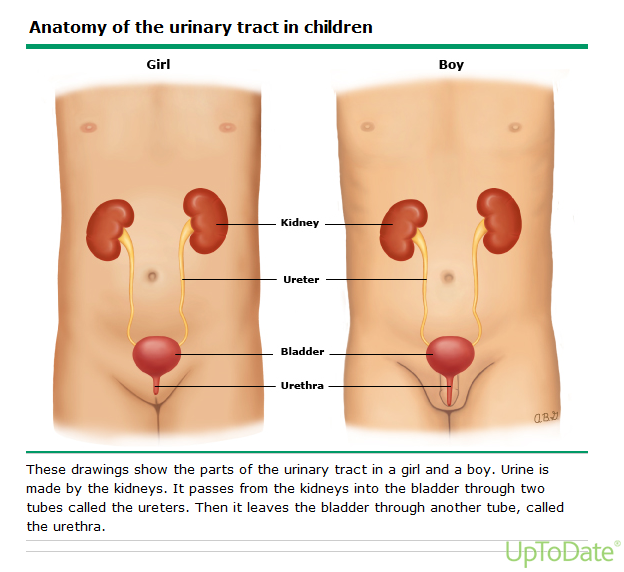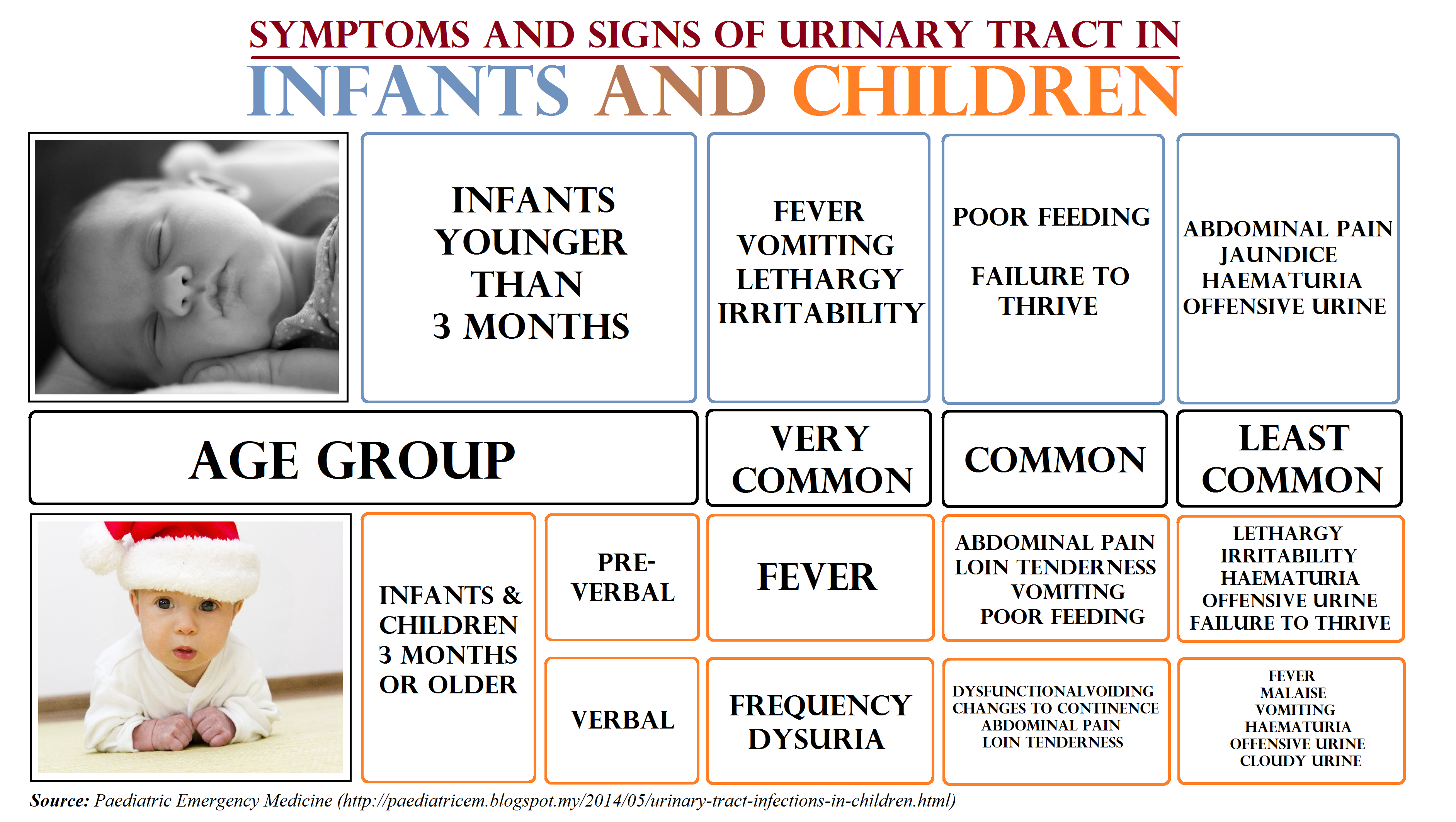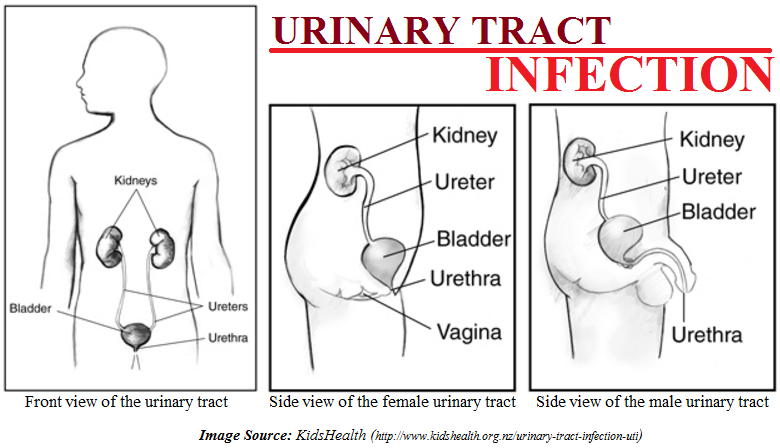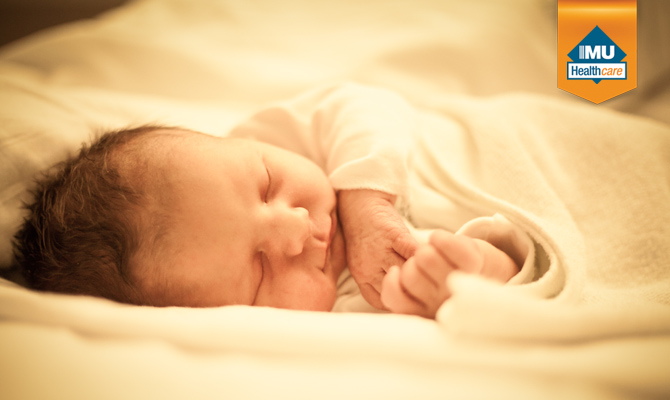|
10-months-old Zara has been having high grade fever with chills for the last few days. Her parents had been dutifully giving her Paracetamol every few hours but the fever does not seem to abate. Apart from the fever, Zara did not have any other symptoms so her parents continued to just monitor her at home. However one day, her fever became more hectic and she started vomiting her feeds and appeared listless. Her parents rushed her to the emergency room where doctors who attended to her found her to have very high spiking temperatures with rapid heart rate but no other obvious focus of infection. Subsequent tests showed evidence of infection and a urine test confirmed a diagnosis of a urinary tract infection (UTI). |
The urinary tract system consists of the kidneys, which make urine; the ureters, tubes that carry urine from the kidneys to the bladder; the bladder, which stores urine until the body is ready to empty it; and the urethra, the tube that carries urine from the bladder out of the body infection. These areas are normally free from bacteria. When bacteria enter the bladder or kidneys, an infection can develop. These infections are called urinary tract infections (UTI).  Bacteria can get into the bladder or kidneys by travelling up through the urethra and in small number of children, spread through the blood stream to the urinary tract system. Most urinary tract infections in healthy children are caused by a type of bacteria called Escherichia Coli, which is found in normal stools. These bacteria spread from the anus up to the genital-urinary tract. Babies are susceptible to UTIs because for the most part they’re in diapers which keep their genital area moist and warm and allows bacteria to breed. If diapers are not changed quickly after bowel movements, bacteria can easily get into the genitals and sometimes cause an infection. Because girls have a shorter distance between the end of the urethra and the bladder than boys do, girls seem to have a higher chance of getting an infection this way. About 8 percent of girls and 2 percent of boys will have at least one urinary tract infection during childhood. Before the age of 1 year, though, UTIs are more common in boys than girls. Other risk factors predisposing to urinary tract infections include being born with an abnormal urinary tract system, an obstructed ureter, a poorly functioning bladder and a bladder catheter that has been left too long inside the bladder. Uncircumcised boys have higher incidence of urinary tract infection even though MOST uncircumcised boys do NOT have urinary tract infections. Some children have problems with urinary reflux. When this occurs, the urine instead of travelling down and out through the urethra, some of it flows backward from the bladder up into the kidney, and it may carry invading bacteria into the kidney itself. Though urinary reflux may improve as a child grows up, it can cause repeated infections in infancy and early childhood. Factors which cause retention of urine for prolonged periods such as severe constipation can also lead to recurrent urinary tract infections.
Bacteria can get into the bladder or kidneys by travelling up through the urethra and in small number of children, spread through the blood stream to the urinary tract system. Most urinary tract infections in healthy children are caused by a type of bacteria called Escherichia Coli, which is found in normal stools. These bacteria spread from the anus up to the genital-urinary tract. Babies are susceptible to UTIs because for the most part they’re in diapers which keep their genital area moist and warm and allows bacteria to breed. If diapers are not changed quickly after bowel movements, bacteria can easily get into the genitals and sometimes cause an infection. Because girls have a shorter distance between the end of the urethra and the bladder than boys do, girls seem to have a higher chance of getting an infection this way. About 8 percent of girls and 2 percent of boys will have at least one urinary tract infection during childhood. Before the age of 1 year, though, UTIs are more common in boys than girls. Other risk factors predisposing to urinary tract infections include being born with an abnormal urinary tract system, an obstructed ureter, a poorly functioning bladder and a bladder catheter that has been left too long inside the bladder. Uncircumcised boys have higher incidence of urinary tract infection even though MOST uncircumcised boys do NOT have urinary tract infections. Some children have problems with urinary reflux. When this occurs, the urine instead of travelling down and out through the urethra, some of it flows backward from the bladder up into the kidney, and it may carry invading bacteria into the kidney itself. Though urinary reflux may improve as a child grows up, it can cause repeated infections in infancy and early childhood. Factors which cause retention of urine for prolonged periods such as severe constipation can also lead to recurrent urinary tract infections.
What symptoms could indicate a UTI?
In older kids, they would be better able to share the most obvious symptoms of UTI – burning or pain with urination. Babies and young children can’t tell you about their discomfort when going to wee wee and because they are in diapers, as a parent, you may not notice them going more frequently.  In infants and young children, UTIs may be harder to spot because symptoms are also less specific. For the “lucky” few, detectable symptoms may include bloody or cloudy urine or even foul-smelling urine. But for majority of babies, an unexplained fever is the only symptom. About 5 percent of babies who have a fever without other symptoms have a UTI. This leads to many UTIs in infants going undetected, according to the American Academy of Pediatrics. Aside from fever (with no obvious cause such as a rash or cough), signs of a UTI in babies and young children can include irritability, loss of appetite, vomiting, being listless — being lethargic (very tired and lacking energy) or behaving just ‘not quite right’, poor weight gain and jaundice in newborn babies which continues for more than 2 weeks. If undetected for a prolonged period, a simple UTI in young babies or children may lead to infection which spreads to involve the kidneys, or spreads into the blood stream. If kidney infections are not treated quickly, the infection can permanently damage the kidneys. Rarely, damage to the kidney can lead to high blood pressure and kidney failure later in life. Blood stream infections can lead to sepsis which is a life threatening condition. Signs of this can include high fever, abdominal pain, persistent vomiting, shivering and drowsiness.
In infants and young children, UTIs may be harder to spot because symptoms are also less specific. For the “lucky” few, detectable symptoms may include bloody or cloudy urine or even foul-smelling urine. But for majority of babies, an unexplained fever is the only symptom. About 5 percent of babies who have a fever without other symptoms have a UTI. This leads to many UTIs in infants going undetected, according to the American Academy of Pediatrics. Aside from fever (with no obvious cause such as a rash or cough), signs of a UTI in babies and young children can include irritability, loss of appetite, vomiting, being listless — being lethargic (very tired and lacking energy) or behaving just ‘not quite right’, poor weight gain and jaundice in newborn babies which continues for more than 2 weeks. If undetected for a prolonged period, a simple UTI in young babies or children may lead to infection which spreads to involve the kidneys, or spreads into the blood stream. If kidney infections are not treated quickly, the infection can permanently damage the kidneys. Rarely, damage to the kidney can lead to high blood pressure and kidney failure later in life. Blood stream infections can lead to sepsis which is a life threatening condition. Signs of this can include high fever, abdominal pain, persistent vomiting, shivering and drowsiness.
How do You Treat a UTI?
Antibiotics are the main treatment for UTIs. Treatment is usually for 3 to 7 days. This depends on several factors, including how unwell your child is and whether they have underlying kidney problems. While religiously dosing out the antibiotics, it is also a good idea for parents to get their child to drink as much fluid as possible. This will increase urination and help to flush out the kidneys and get them back to normal.  If your baby has had a UTI and is under 12 months of age, they may need further investigation. The most common investigation is a renal ultrasound. This is to find out if there are any blockages and to check if the kidneys are normal in shape, size and position. If there are issues with the kidney, a renal scan may be required to allow the doctor to find out if there is any scarring in a baby’s kidneys, which can affect how well they work. Another type of test would be the Micturating Cysto-urethrogram. This hard to pronounce big word just means that it’s a test which allows the doctor to check to see if the urine is flowing backwards from the bladder back up into the kidneys Urinary tract infections, if detected early, are usually pretty easy to treat with antibiotics and drinking a lot of extra fluids. As a preventive measure, it is important for parents to clean a baby really, really well when they change their diapers so that germs cannot get from the digestive tract to the urinary tract. And changing diapers often and keeping baby clean can also prevent them from happening in the first place! References: http://www.nhs.uk/conditions/Urinary-tract-infection-children/Pages/Introduction.aspx https://www.niddk.nih.gov/health-information/health-topics/urologic-disease/urinary-tract-infection-in-children/Pages/ez.aspx http://www.webmd.com/children/tc/urinary-tract-infections-in-children-topic-overview#1 http://healthstoriesforkids.com/baby-health-babies-and-urinary-tract-infection/ http://www.babycenter.com/0_urinary-tract-infection-in-babies_10910.bc This article is brought to you by IMU Healthcare.
If your baby has had a UTI and is under 12 months of age, they may need further investigation. The most common investigation is a renal ultrasound. This is to find out if there are any blockages and to check if the kidneys are normal in shape, size and position. If there are issues with the kidney, a renal scan may be required to allow the doctor to find out if there is any scarring in a baby’s kidneys, which can affect how well they work. Another type of test would be the Micturating Cysto-urethrogram. This hard to pronounce big word just means that it’s a test which allows the doctor to check to see if the urine is flowing backwards from the bladder back up into the kidneys Urinary tract infections, if detected early, are usually pretty easy to treat with antibiotics and drinking a lot of extra fluids. As a preventive measure, it is important for parents to clean a baby really, really well when they change their diapers so that germs cannot get from the digestive tract to the urinary tract. And changing diapers often and keeping baby clean can also prevent them from happening in the first place! References: http://www.nhs.uk/conditions/Urinary-tract-infection-children/Pages/Introduction.aspx https://www.niddk.nih.gov/health-information/health-topics/urologic-disease/urinary-tract-infection-in-children/Pages/ez.aspx http://www.webmd.com/children/tc/urinary-tract-infections-in-children-topic-overview#1 http://healthstoriesforkids.com/baby-health-babies-and-urinary-tract-infection/ http://www.babycenter.com/0_urinary-tract-infection-in-babies_10910.bc This article is brought to you by IMU Healthcare.









